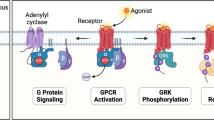Abstract
Agonist occupancy of high affinity histamine H3 receptors on AtT-20 cells induces increased ACTH release. However, the signal transduction process by which this occurs is presently unknown. As a first step in characterizing this pathway, we have examined the effects of a variety of nucleotides and nucleotide analogs on Na-methylhistamine binding to these receptors. Nonhydrolyzable guanine nucleotide analogs inhibit up to 40% of the [3H]Na-methylhistamine binding by increasing the dissociation rate of the ligand from the receptor and thereby, reducing receptor affinity. Pertussis toxin also decreases the affinity of the H3 receptors and ADP ribosylates a 41 kDa protein. Neither GTPγS nor pertussis toxin changeB max. These data indicate that the H3 receptors on these cells are coupled to a G protein of the Gi subclass.
Similar content being viewed by others
References
S. J. Hill,Distribution, properties and functional characteristics of theree classes of histamine receptor. Pharmacol. Rev.42, 45 (1990).
J. M. Arrang, M. Garbarg and J. C. Schwartz,Auto-inhibition of brain histamine release mediated by a novel class (H 3)of histamine receptor. Nature302, 832 (1983).
J. M. Arrang, M. Garbarg, J. C. Lancelot, J. M. Lecomte, H. Pollard, M. Robba, W. Schunack and J. C. Schwartz,Highly potent and selective ligands for histamine H 3-receptors. Nature327, 117 (1987).
A. Korte, J. Myers, N. Y. Shih, R. W. Egan and M. A. Clark,Chanacterization and tissue distribution of H 3 histamine receptors in guinea pigs by N a-methylhistamine. Biochem. Biophys. Res. Commun.168, 979 (1990).
R. E. West, Jr., A. Zweig, N. Y. Shih, M. I. Siegel, R. W. Egan and M. A. Clark,Identification of two H 3-histamine receptor subtypes. Mol. Pharmacol.38, 610 (1990).
R. E. West, Jr., A. Zweig, R. T. Granzow, M. I. Siegel and R. W. Egan,Biexponential kinetics of (R)-a[3 H]methylhistamine binding to the rat brain H 3 histamine receptor. J. Neurochem.55, 1612 (1990).
Y. Cherifi, C. Pigeon, M. LeRomancer, A. Bado, F. Reyl-Desmars and M. J. Lewin,Purification of a histamine H 3 receptor negatively coupled to phosphoinositide turnover in the human gastric cell line HGT1. J. Biol. Chem.267, 25315 (1992).
M. A. Clark, A. Korte, J. Myers and R. W. Egan,High affinity histamine H 3 receptors regulate ACTH release by AtT-20 cells. Eur. J. Pharmacol.210, 31 (1992).
M. A. Clark, T. M. Conway, C. F. Bennett, S. T. Crooke and J. M. Stadel,Islel-activating protein inhibits leukotriene D 4-and leukotriene C 4-but not bradykinin- or calcium ionophore-induced prostacyclin synthesis in bovine endothelial cells. Proc. Natl. Acad. Sci. USA83, 7320 (1986).
U. K. Laemmli,Cleavage of structural proteins during the assembly of the head of bacteriophage T4, Nature227, 680 (1970).
M. M. Bradford,A rapid and sensitive method for the quantitation of microgram quantities of protein utilizing the principle of protein-dye binding. Anal. Biochem.72, 248 (1976).
G. Scatchard,The attraction of proteins for small molecules and ions. Ann. N.Y. Acad. Sci.51, 660 (1949).
T. Murayama and M. Ui,Receptor-mediated inhibition of adenylate cyclase and stimulation of arachidonic acid release in 3T3 fibroblasts. Selective susceptibility to islet-activating protein, pertussis toxin. J. Biol. Chem.260, 7226 (1985).
F. Okajima and M. Ui,ADP-ribosylation of the specific membrane protein by iselt-activating protein, pertussis toxin, assiaiated with inhibition of a chemotactic peptide-induced arachidonate release in neutrophils. A possible role of the toxin substrate in Ca 2+-mobilizing biosignaling. J. Biol. Chem.259, 13863 (1984).
G. M. Bokoch and A. G. Gilman,Inhibition of receptormediated release of arachidonic acid by pertussis toxin. Cell39, 301 (1984).
D. G. Raible, E. S. Schulman, J. DiMuzio, R. Cardillo and T. J. Post,Mast cell mediators prostaglandin-D 2 and histamine activate human eosinophils. J. Immunol.148, 3536 (1992).
M. E. Maguire, P. M. Van Arsdale and A. G. Gilman,An agonist-specific effect of guanine nucleotides on binding to the beta adrenergic receptor. Mol. Pharmacol.12, 335 (1976).
T. Michel, B. B. Hoffman and R. J. Lefkowitz,Differential regulation of the a 2-adrenergic receptor by Na + and guanine nucleotides. Nature288, 709 (1980)
S. Mong, H. L. Wu, G. K. Hogaboom, M. A. Clark, J. M. Stadel and S. T. Crooke,Regulation of ligand binding to leukotriene D 4 receptors: Effects of cations and guanine nucleotides. Eur. J. Pharmacol.106, 241 (1984).
M. Rodbell,The role of hormone receptors and GTP-regulatory proteins in membrane transduction. Nature284, 17 (1980).
Author information
Authors and Affiliations
Rights and permissions
About this article
Cite this article
Clark, M.A., Korte, A. & Egan, R.W. Guanine nucleotides and pertussis toxin reduce the affinity of histamine H3 receptors on AtT-20 cells. Agents and Actions 40, 129–134 (1993). https://doi.org/10.1007/BF01984051
Received:
Accepted:
Issue Date:
DOI: https://doi.org/10.1007/BF01984051




